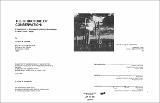The structure of conservation : experiments in representing design knowledge for arid lands design
Author(s)
Bennett, Andrew M. (Andrew Michael)
DownloadFull printable version (18.53Mb)
Alternative title
Experiments in representing design knowledge for arid lands design
Other Contributors
Massachusetts Institute of Technology. Department of Architecture.
Advisor
Frank Miller.
Terms of use
Metadata
Show full item recordAbstract
This thesis proposes, through a multi-layered exploration, the development of a system of computer tools for architects. The research consists of a series of "design sessions" in the context of a desert design problem. The goal is to create a knowledge-based system using a commercially available expert shell, which provides the designer with an automated interface to visual references. Data can be seen as a collection of things, while knowledge can be similarly seen as a collection of relationships between things. An expert shell is literally a program that is "empty" of knowledge, and into which a designer puts know ledge: a knowledge-base is the result. The shell itself acts as a means of manipulating that knowledge-base by an inference process that is activated by rules, or hypotheses and tests. The experimental framework of the thesis is devised to evaluate both type of inference processes in relation to their capabilities for representing design knowledge. The design problem serves to outline a methodology for understanding the process of design, but it also is the means by which a design grammar and syntax appropriate to the automated system are formally described. The intent is not to compile a vast domain of knowledge on all issues of arid lands design, but to focus on a specific architectural response to the climate: the relationship between the primary structural system and the secondary closure system. The design of a window system is the vehicle for documenting observations of the way visual references are used. From this process a descriptive system and body of "expert" rules are developed to define the function of the automated environment. The larger goal is to then relate the syntactical environment to a general image referencing system so that the expert system can act as a personal design consultant. The image referencing system is a distinct and important component of the automated environment, and as such a detailed specification of its nature and operation is intended to show the interdependence of the knowledge-base and a visual database.
Description
Thesis (M. Arch.)--Massachusetts Institute of Technology, Dept. of Architecture, 1987. MICROFICHE COPY AVAILABLE IN ARCHIVES AND ROTCH. Includes bibliographical references (leaves 54-55).
Date issued
1987Department
Massachusetts Institute of Technology. Department of ArchitecturePublisher
Massachusetts Institute of Technology
Keywords
Architecture.